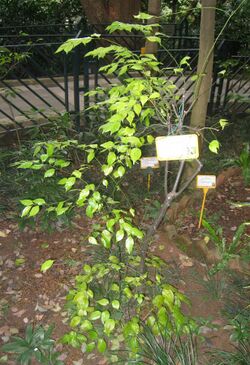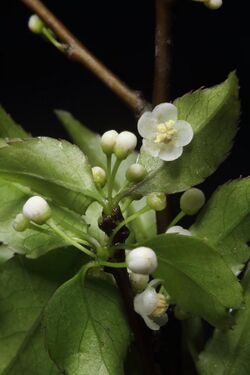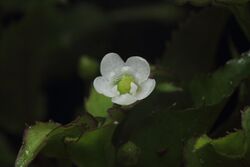Biology:Ilex asprella
| Ilex asprella | |
|---|---|

| |
| Ilex asprella - Hong Kong Botanical Garden | |
| Scientific classification | |
| Kingdom: | Plantae |
| Clade: | Tracheophytes |
| Clade: | Angiosperms |
| Clade: | Eudicots |
| Clade: | Asterids |
| Order: | Aquifoliales |
| Family: | Aquifoliaceae |
| Genus: | Ilex |
| Species: | I. asprella
|
| Binomial name | |
| Ilex asprella (Hook. & Arn.) Champ. ex Benth.
| |
Ilex asprella, also known as rough-leaved holly and plum-leaved holly, is a deciduous shrub native in South East Asia. Ilex asprella is one of the few deciduous species in the family Aquifoliaceae.
Morphology
A densely branched deciduous shrub, growing up to 3 m tall. The long shoots glabrous, brown, and slender, while the short shoots green with significant white lenticels. Leaves thin-chartaceous, glandular-punctate on the back, ovate, 4 to 5 cm in length, 1.5 to 2.5 cm broad. Leaf apex acuminate, leaf base cuneate, leaf margin sermlate, hirsute on adaxial nerves and nearly glabrous beneath. Petioles 3 to 8 mm long. Reticulate veins with 6 to 8 pairs of pinnate lateral veins.
White flowers in axillary umbels with slender pedicels, dioecy. Male flower: 2 to 5 flowers each inflorescence, 2.5 to 3 mm in diameter, glabrous; 4 or 5 suborbicular petals, margin erose, corolla rotate, base slightly connate; stamens ca. 3/4 as long as petals, anthers oblong and ca. 1 mm. Female flower: 4 to 6 flowers each inflorescence, glabrous, ca. 3 mm in diameter; flowers 4-6; calyx deeply 4 to 6 lobed; corolla rotate, petals suborbicular, basal slightly connate; staminodes ca. 1 mm, sterile anthers sagittate; ovary ovoid, ca. 1.5 mm in diameter, style present, stigma thickly discoid.
Drupe black and globose, endocarp stony, 5 mm long, 4 mm across, pedicel 2 to 3 cm long.[1][2][3]
Distribution
Adapted to tropic climate and hummus soil. Can be found in low altitude about 400 to 1000 m in Luzon, S. E. China, and Taiwan in the thickest.[4]
Usage
Used as a traditional Chinese medicine for multiple effects. The root is dug out during winter and dried in daylight. It is either cooked and consumed as soup or smashed and applied on the skin.[5]
References
- ↑ "Ilex asprella in Flora of China @ efloras.org". www.efloras.org. http://www.efloras.org/florataxon.aspx?flora_id=2&taxon_id=200012751. Retrieved 2017-03-30.
- ↑ "電子書 台灣植物誌第二版 Flora of Taiwan, 2nd edition 3: 622 – Plants of Taiwan 台灣植物資訊整合查詢系統". tai2.ntu.edu.tw. http://tai2.ntu.edu.tw/ebook/ebookpage.php?book=Fl.%20Taiwan%202nd%20edit.&volume=3&page=622. Retrieved 2017-03-30.
- ↑ "燈稱花 Ilex asprella – Plants of TAIWAN 台灣植物資訊整合查詢系統". tai2.ntu.edu.tw. http://tai2.ntu.edu.tw/PlantInfo/species-des.php?code=430%20001%2002%200. Retrieved 2017-03-30.
- ↑ "電子書 台灣植物誌第二版 Flora of Taiwan, 2nd edition 3: 624 – Plants of Taiwan 台灣植物資訊整合查詢系統". tai2.ntu.edu.tw. http://tai2.ntu.edu.tw/ebook/ebookpage.php?book=Fl.%20Taiwan%202nd%20edit.&volume=3&page=624. Retrieved 2017-03-30.
- ↑ "岗梅根_中药材_中医世家". http://www.zysj.com.cn/zhongyaocai/yaocai_g/gangmeigen.html.
Wikidata ☰ Q11115336 entry
 |



